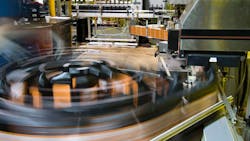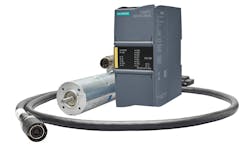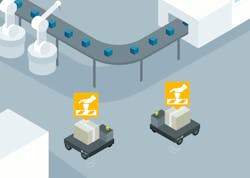Low-Voltage DC Drives for Battery-Powered Motion Control
Applications often end up with poorly-specified drives and other motion-control components. Often that is because engineers and designers overlook characteristics such as motor type, torque, power and ambient operating conditions, and the available and application-preferred voltage. The mismatch is typically due to short-sightedness and the commonly accepted idea that alternating current drives are better suited for industrial applications than direct current drives. (Drives are the devices that amplify signals from controller, so they can power a motor.)
On many plant floors, AC power is highly accessible for powering motors, though that is not always the case. But even when DC voltage is more accessible, many engineers still steer away from DC motors because readily available extra-low-voltage (5 to 12 Vdc) drives cannot handle the rigor of hostile plant environments. This is due to their lack of power and robustness, but modern high-performance low-voltage DC drives solve these problems for manufacturers.
Here’s a look at which newer DC drives could be used and the characteristics making these high-performance drives suitable for industry.
AC Drive Limitations
While medium- to high-voltage (120 to 480 Vac) variable frequency, servo and stepper drives fulfill many motion control needs for typical plants, AC power is sometimes unavailable or unacceptable for certain applications, such as in:
- Battery-driven applications.
- Small machines with low power requirements, because high voltages require increased engineering effort due to safety planning.
- Compact machines that need small, high-performance motors, where motor acceleration and efficiency is critical.
- Safety reasons regarding electrical and motion hazards for workers, which are more pronounced with AC motors.
Traditional AC drives are also bulkier and more complicated to configure than DC motors. Plus, they are not as efficient as DC motors, even at full speed.
Many DC drives, on the other hand, lack the reliability of traditional industrial AC drives. Regardless of the supply voltage, plant managers cannot settle for unpredictable consumer-grade electronic components when their chief goal is to ensure maximum uptime.
DC Alternatives
For plant managers and designers facing these concerns when selecting a motor and drive, modern high-performance low-voltage drives are worth consideration. When used in single or multi-axis applications with 24 to 48 Vdc motors, they are safer for operations in close proximity to humans than higher voltage AC alternatives. This is due to lower risk of electrocution and their safety-limiting torque (SLT) and speed (SLS) capabilities. These dives can also be used with a battery supply and, unlike consumer-grade drives, they are industrially hardened to withstand extreme temperatures and vibration.
Modern DC drives are simple to set up, even for non-experts, with step-by-step wizards in their automation software suites for initialization alongside PLC, HMI and network architectures. The drives have embedded software for seamless control from a PLC or other controller and to work with the automation platform.
When used in safety devices, engineers can take advantage DC drives’ SLT and SLS features to limit hazards. This is done by monitoring motor current and speed through a controller connected to the drives. Programmers can collect motor data through any compatible controller over its native communication protocol, such as PROFINET, and use the data at the source or transmit it elsewhere for additional analysis.
For common applications, smart encoders and one-button tuning make DC drives nearly plug-and-play, with onboard auto-controller optimization and drive diagnostics. Wiring is kept simple with a single cable to supply power, control motor movements and process encoder feedback. Parameter backups can be stored on a drive’s interface module or a connected controller.
Low-voltage DC drives are suited to a wide range of variable speed, positioning, synchronous axis, and gearing applications, driving motors rated up to 1,000 W. A few examples include storage and retrieval warehouse systems, automated guided vehicles (AGV), picking and sorting machines, and medical devices. The drives are compact and can be rail-mounted side-by-side.
Because their corresponding electronically commutated DC motors contain no parts that wear, such as fans or brushes, these motors last for years with little maintenance. The drives can activate or deactivate onboard braking choppers—drive elements that dissipate a motor’s excess power. This lets the drives be set up for energy recovery by deactivating them in battery-operated applications. This reduces power requirements and improves battery life for mobile and remote systems.
DC Drive in Action
At a large-scale distribution and fulfillment center, the owner added a fleet of shuttles and AGVs to transport goods and packages around the vast facility. With a Siemens servo converter in each of its AGVs, engineers created a safe, battery-powered, low-voltage network of vehicles aware of their positions relative to the warehouse and other AGVs. This was made possible using the servo’s programmability for seamless use in the automation set-ups. SLT and SLS safety functions could not have been achieved with traditional AC motors and drives.
With SLT and SLS constraints, the AGVs executed precise movements without collision or harm to personnel or equipment. These capabilities were provided using only proximity sensors, a wireless communication chip, a low-voltage drive, a motor and a small number of onboard components.
As the drives applied braking when the AGVs moved through the warehouse, the deactivated PDC choppers enabled energy recovery for battery recharging. The entire fleet of shuttles and AGVs used a web of wireless communication modules, with fast and secure connection to a PLC via a communication protocol for controlling all motor movements through the drives.
In another application, PDC servos were installed at a paper product manufacturer’s facility on its sorting line to pick up and move different products to the appropriate palettes for storage or truck loading. The drive worked well in this application due to its low power draw, along with multi-axis interpolation coordination for accurate and efficient product placement.
The manufacturer used Siemens TIA Portal automation software to design and program the conveyance and sorting-automation system, including drive, PLC, HMI and network hardware, along with safety functions. Because the components were programmed in a common software suite, configuring connectivity to the cloud was simple. The manufacturer set up motor data collection and processing by adding an encoder to each motor, then establishing a schedule of automatically generated reports to monitor motor health over time.
In a third application, a PDC Servo was used in a magnetic resonance imaging facility to precisely, safely and automatically move the bed on which patients lie into the imaging chamber. During operation, the motor data including current and torque are collected and processed ensuring patient safety throughout the imaging process.
One of the main factors leading to the imaging facility’s selection of the Micro-Drive was its low-voltage requirement for safe and reliable operation in close proximity to patients. The drive’s built-in safety functions reduced development time for the application, and the drive’s PROFIsafe communication with the control network increased confidence in the entire system’s safety functions.
For many industrial applications, engineers and designers initially turn to traditional AC VFD and servo drives. Although these remain the most commonly used drives, engineers are wise to keep in mind the availability of low-voltage industrial DC drives.
Some applications operate best with traditional AC drives and motors, but in certain cases, high-performance low-voltage DC drives are preferred. These include cases in which the application requires:
- Heightened human-safety due to DC drives’ lower electrical shock hazards than their AC counterparts and their ability to limit torque and speed to user-defined quantities.
- More precise motor movements because AC drives cannot provide the same quick speed and direction changes.
- Battery operation.
- Other cases when high-voltage AC is inaccessible or inconvenient.
These drives provide reliable and highly-configurable motor control and, when properly selected, can help meet the needs of industrial applications.
Kevin Wu is the SIMATIC Motion Controllers product marketing manager for Siemens Industry in the United States.



